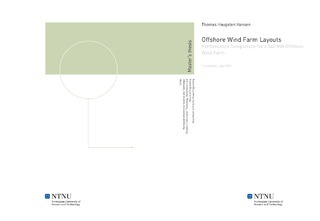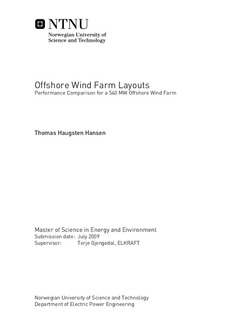| dc.description.abstract | This master thesis has been written at the Department of Electric Power Engineering at the Norwegian University of Science and Technology. The work has been carried out at the Royal Institute of Technology in Stockholm, where the author spent the last year of his studies as an exchange student. In the thesis, six different designs of the electrical grid of a 540 MW offshore wind farm, placed 100km off the Norwegian coast, have been studied and compared. At this distance, AC cable transmission might be difficult because of the reactive power production in the cables. Taking this into consideration, two options for the transmission system to shore have been studied. In addition to the AC cable transmission, voltage source converter based HVDC transmission, in the form of HVDC Light, has been studied, giving a total of 12 models. The main scope of the thesis was to study the load flow situation and power system performance of the different offshore wind farm layouts. Two load flow cases were run for each model; the first studying the model when the active power transmission to shore was maximized, the second studying the model under a contingency situation. The reliability of the six designs was compared by calculating the expected number of cable failures during the life time of the wind farm for each design, and what consequence the disconnection of any cable would have on the power losses. In order to study the effect of the offshore grid design and transmission system design on the offshore power system stability, dynamic simulations have also been executed, and the voltage response and rotor speed response following a fault have been studied. All simulations have been executed in version 31 of the program PSS/E. The wind farm was modeled full scale, consisting of 108 wind turbines rated at 5MW. The wind turbines were modeled as doubly fed induction generators, using the generic wind model that comes with the program. The load flow simulations showed that an AC cable connection to shore gave lower total system losses than a DC connection for all designs. The lowest losses were found at the n-sided ring design in the AC/AC system, and the highest losses were found for the star design in the AC/DC system. These losses were 2.33% and 8.19% of the total installed capacity, respectively. In the dynamic simulations, a three phase short circuit fault, lasting 150ms, was applied at three different places in the system. The simulations showed that except from at the wind turbines that were islanded as a result of a fault, all dynamic responses were stable. The HVDC Light transmission to shore gave the highest voltage drops and the lowest voltage peaks offshore. Also, the maximum speed deviation was found to be larger when using HVDC Light transmission compared to using AC cables, with two exceptions; the radial and star designs when a fault was applied to the transmission system. A comparison of the six different grid designs showed that the results were varying. Based on the results in this thesis it has not been concluded that one of the offshore designs have better dynamic qualities than the other. The simulation results indicated that this is case specific, and more dependent on where in the offshore grid the fault occurs rather than the design of the offshore grid. | nb_NO |

